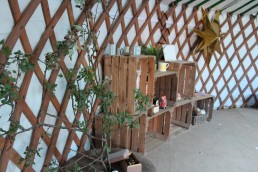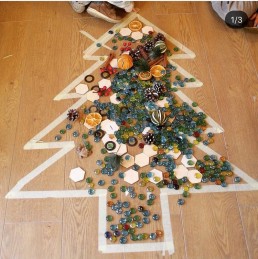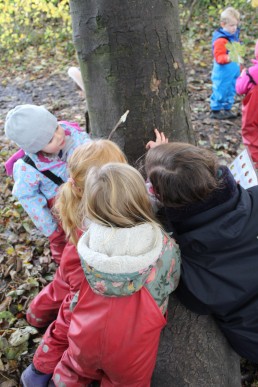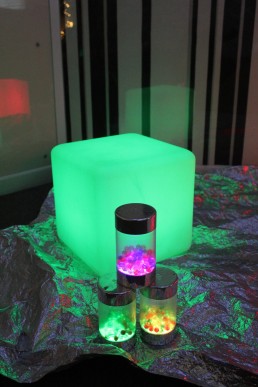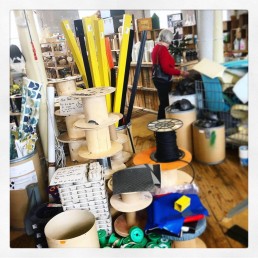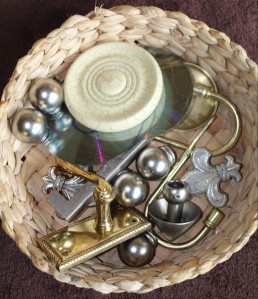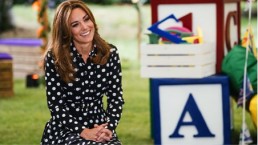Pre-School at Horsforth
Happy New Year to everyone, it sure has been an eventful start to the year as we continue to tackle a pandemic with 3 inches of snow thrown in to test us. But hope and positivity prevails, and we really valued your responses to our previous blog on the little steps we can all take to create a more sustainable year.
We thought we would start the year of blogs by taking a look at our Pre-School Settings across Horsforth and Adel. Currently our Pre-School bubble at Horsforth has closed, so for those affected we are posting daily activities and zooms for the children, you can find all the information you need on Tapestry.
We start by looking back at 2018- the time we implemented the Reggio Approach into our classrooms, changed our name from Dolphins to Inspirations, and rebuilt our entire Pre-School area. This change meant moving the Toddler Room into the old Pre-School room, opening up a second Baby Room, and building a Yurt, Outdoor Class Room and Art Studio on the patch of un-used grass land behind our nursery.
Our Yurt



Flattening the land for our Mongolian Yurt was quite the task, over the spring months of 2018 the changes were finalised and after calling in help from some of our parents, together with Colin the Yurt was erected in just a couple of days. The Yurt is a unique space and feature at Inspirations that provides just one of many learning areas for our Pre-School children. It is a cosy space to warm up in adverse weather and to eat their meals during winter. The yurt is filled with literacy areas, maths areas, open ended resources and books for reading and researching. See more about our Yurt here- http://simonr30.sg-host.com/our-yurt/
Outdoor Classroom



Our children are predominantly outdoor learners, and our outdoor classroom is a constantly changing space that matches the children's interests and mirrors seasonal changes. Adapting our classroom to match their interests invites our curious young minds to explore and discover, and is the perfect space for them to unleash their creativity.
No Fear of Failure
Throughout our Pre-School areas room Reggio Emilia is of course the guiding principle, and our spaces reflect that. Our Project based approach provides the backbone of their learning, so it is important that our environment and educators support their creative thought process without any fear of failure.
Exciting News
 This January are excited to announce a brand new Room Leader for our Pre-School room. Jennie is an experienced Reggio inspired Early Years Educator who over the course of the last 15 years has worked in Dubai, Japan, Angola and Vietnam and has been to Reggio Emilia three times. We’re very excited that she has joined our team and brings her passion for our pedagogy and supporting children through child- led learning. Her email address is jennie@inspirationsnurseries.co.uk if you would like to get in touch.
This January are excited to announce a brand new Room Leader for our Pre-School room. Jennie is an experienced Reggio inspired Early Years Educator who over the course of the last 15 years has worked in Dubai, Japan, Angola and Vietnam and has been to Reggio Emilia three times. We’re very excited that she has joined our team and brings her passion for our pedagogy and supporting children through child- led learning. Her email address is jennie@inspirationsnurseries.co.uk if you would like to get in touch.
If you’re interested in your child joining our Pre-School over 3’s room please take a look at our website and get in touch with Kayleigh@inspirationsnurseries.co.uk.
 In next weeks blog we will be taking a look at our Pre-School setting over at Adel. In the mean time stay safe in the snow and please do send in any photos you have out exploring the weather. We will select some highlights to share on our social media this weekend.
In next weeks blog we will be taking a look at our Pre-School setting over at Adel. In the mean time stay safe in the snow and please do send in any photos you have out exploring the weather. We will select some highlights to share on our social media this weekend.
"We value space to create a handsome environment and its potential to inspire social, affective and cognitive learning. The space is an aquarium that mirrors the ideas and values of the people who live in it" -Loris Malaguzzi
- Nathalie
Taking Care of the Little Things
The year is coming to an end, and this December has been a time to reflect on many things, including our sustainability as a nursery. There are many things we do at Inspirations to be as sustainable possible, not only to save our planet from harm but also because it is essential for human well-being.
With 1 in 6 of the world's species facing extinction, a growing pollution problem, and a pandemic jeopardising the health of loved ones we are reminded how important it is to teach our younger members of society how to help us take care of our planet.
Taking care of the little things helps the big things fall into place.
Children often mirror behaviour of their adults or carers, so what do we do at our nursery to help save the planet?
- Recycling- We have a recycling bin in all of our rooms and staff room, and in the older rooms we teach the children which bins they can put their rubbish in. Helping them get into the habit of considering which bin things should go into will stay with them in the future.
- Use less paper- This is a tricky one at nursery as we would never want to limit a child's creativity. Recently we acquired paper from a local company that was scrap and headed for the bin. We also use white boards, blackboards, chalks, digital drawings, and transient art using loose parts. All of these help to reduce the amount of paper waste.
- Outdoor learning- Our pre-school setting is primarily outdoor, with outdoor play being a huge part of the younger age groups also. "Playing in natural spaces supports a child's sense of self, allowing children to recognise their independence alongside an interdependence and connectedness with their ecological worlds.''
- Reduce and Reuse- We said goodbye to plastic toys a few years ago, and swapped these for more natural ambiguous resources. We repurpose old cable reels throughout, and will always aim to acquire our resources second hand or from SCRAP.
Read more about where we shop- http://simonr30.sg-host.com/news-and-blog/loose-parts-in-the-community/



- Wormery Composting- The children in pre-school take great pleasure in putting their wasted fruit and veg into our wormery. About a third of household waste is organic, so by recycling this as compost we are reducing the amount of waste sent to landfill.
- Water Play- We teach our children that water is a precious resource and that it should be used wisely and reused where possible. To support this we discourage water play from the sinks and taps and instead use purpose build water basins for them to explore water in, and use this to water the garden after use.
- Growing Fruit and Veg- We grow fruit and veg from potatoes to strawberries, our children can learn the pleasure and reward from growing their own food at nursery.
- Care for living things- From bee hotels to worm houses, from night-cams capturing local wild life to having our own nursery dog, it is instilled in our children from a young age to treat all of our insects and wild life and with love, care and respect.



Striving to Improve
There's still so much more we want to do at Inspirations to be sustainable and are constantly growing and developing. We are currently in the process of building a nature reserve with a pond behind our yurt- updates to follow.
Please share with us how you at a home or in a nursery setting help to create a a more sustainable environment, maybe you can inspire us here at Inspirations. This Christmas why not consider second hand books or toys or gifting experiences rather than material possessions.
That's a wrap
As we wrap up our blogs for 2020; the year we will always remember, let's make sure we wrap only with paper that can be recycled with brown paper tape, and remember that taking care of our environment will help us build a brighter 2021 for ourselves and our little ones.
-Nathalie
Let's Save The Planet

The difficulties faced globally over the past year make it easier to forget the hot topics of the year before. Looking back over the end of 2019 and beginning of 2020 and remembering the pictures of those red-hot raging fires across Australia, of animals desperately trying to escape the flames, family homes burning and men and women fighting through the smoke and heat futilely trying to combat the flames. It all seems such a long time ago and, in some ways, no longer imposes on us the horror they once did.
The World Has Changed
A pandemic has hit and, in many ways, has made the fires seem further away, maybe not so important, and impactful on our conscience as they once were.
In this distance between one global disaster and another, we have hopefully managed to enjoy, at times, a slower pace of life, we have had the enjoyment of our gardens, our local nature reserve, woodland, park or beach. We have clung to our outdoor spaces seeking the peace, tranquillity and escapism that being outdoors offers us. We have in a sense returned to nature and for many it has soothed troubled souls and helped those many people struggling with their mental health.

You may also have watched the new David Attenborough series EXTINCTION. Within the series he suggests we are currently in what will be the sixth mass extinction of planet Earth with a million species at risk. Our biodiversity is in crisis and he goes so far to say that this lack of biodiversity will, in the future cause more major pandemics and disease amongst the human race.
It is all very overwhelming, daunting, and somewhat scary if you think too deeply or for too long. However, burying our head in the sand will not save our planet. We must do what we can, all we can.
Here at Inspirations, we are naturally, through our ethos of outside learning, Forest school and loose parts play, inspiring our children to appreciate our natural environment, forging a love of nature with a deep-seated respect, and understanding for it. They, with our support and commitment to their futures will turn this all around. They are the generation who will aspire to and ultimately achieve a purely ‘green’ way of living. It is a challenge Children of Inspirations will be well equipped to meet! Read more about our culture and ethos here- http://simonr30.sg-host.com/our-culture/
As parents of the future generation
Like all households and businesses, Inspirations are struggling to maintain our promises to reduce single use items, the pandemic has seen an end to that for now. It does therefore become even more important to do what we can in other areas, like composting, shopping local, not buying plastic covered fruit and veg, walking or cycling where we can. Lots of little things, if we are all joining in, help to make a big difference. They the baby steps we, the parents of the future generation, can do to make it possible for them to take the giant leaps required to save the planet.



2020 is almost over and as we say goodbye to the year that has taught us so much about what is important, I fervently hope and pray that 2021 is happier, healthier and of course more sustainable…
-Nicola
BBC iPlayer - Extinction: The Facts
Every Cloud...
https://www.youtube.com/watch?v=6AAcMqAZlXU
I followed the children into the local woods to see what they got up to on their journey into the forest, you can watch the video on YouTube by following the link above. Unfortunately due to Covid regulations this was the last walk into the woods for a month or so, but every cloud has a silver lining. The children now have their forest school sessions on-site and it has inspired us to make the most out of what we have here.
Forest School On Site

We have added some rope swings over the stream, and a slide down to the forest school area. This week during the forest school sessions our 3 and 4 year olds have been learning how to use a pneumonic drill, they’ve made oat pancakes on the outdoor campfire and are learning how to put on their outdoor suits independently. Staying on-site during forest school has also opened up some team building opportunities and chances to talk and listen around the campfire.
‘I love every shape, every colour and every number’- James 4
It won’t be long until the children can head back into the woods, but in the mean time you’ll find them knee deep in the stream, making art against the bark of trees and mastering our new rope tyre obstacle course. Sometimes it takes a little set back to encourage you to make the absolute most out of what you already have.


The Benefits of Forest School
At Inspirations we value greatly our outdoor environments which are extensive and include the use of our local Horsforth woodland at Hunger Hills. Our passion for outdoor learning and forest school comes from a deep understanding and appreciation for the ethos. The pedagogy was developed in Sweden in the 1950’s and the approach focuses on the natural environment being utilised, not only as an area where children can blow off excess energy but more importantly where children are given the opportunity to immerse themselves in nature.

http://simonr30.sg-host.com/our-settings/forsest-school/
Forest school children develop an appreciation and deep seated love of nature and are able to explore and learn from all that the environment has to offer, at a pace that suits them.
'Lead their own Learning'
The forest school ethos allows for each individual child to lead their own learning journey. They find their own pace, interests and methods of learning and attainment that best suit them. There is no pressure, no preconceived results, no adults determining a beginning or end to their project or interest.
Adults of course play a vital role one which is supportive and patient, they build strong positive relationships which children know they can trust and count on. The Adults help children take managed risks encouraging children to consider, they ask questions and encourage with a hands-on approach which helps supports critical thinking.


Resilience and Determination
Forest school children are shown to be ahead of their peers by the time they start school at the age of five. They show confidence, are very willing to ‘have a go’ and not be deterred by failed attempts. They are resilient and eager to keep trying until they find a positive solution to a problem. It is shows they are effective problem solvers who work well within a team, exhibiting high levels of motivation and concentration to any task facing them.
The forest learning environment also creates strong communicators and gives children a deep level of understanding about the word around them. They are socially advanced, understanding feelings and consequences of their behaviour and are more likely to think before they act. Naturally children who spend time in wide open spaces where the floor is uneven, who have trees to climb and weather to navigate are more confident in their own physical abilities. They are more prone to want to be outdoors as adults and as a result are more healthier, happier individuals.


There are several studies on the benefits of forest school and outdoor learning philosophy. These studies are becoming more prevalent as the ethos has slowly become more popular. Below are a few links to the most recent studies showing the benefits mentioned in our blog above.
https://www.forestschoolassociation.org/new-research-a-longitudinal-study-on-forest-school/
- Nicola

Learning through Light
The Reggio approach (as outlined in our previous blog) puts children at the centre of their own learning. The ethos is based around a hands on approach to learning, with art, materials, and loose parts used to create learning opportunities and encourage critical thinking; but one thing we haven't touched upon much is the use of light as a material.
If you explore our rooms at inspirations, or the photography on our Instagram and website you will see there are projectors, light boxes, and sensory dark dens throughout all of our spaces from the Baby Rooms up to Pre-School.

Why do we use light and shadow?
In the younger rooms the use of light cubes, fairy lights and projectors invite children to expand their natural curiosity and encourage babies to engage and remain focused for a longer period of time. As well as having a calming affect, this sensory experience also provides a different perspective, allowing the child to develop creative and critical thinking.

In the Toddler and Pre-School rooms we use over head projectors, torches and mirrors to allow the children to deepen their knowledge and understanding of light and space. Have you ever witnessed the first time a child acknowledged their own shadow?
Seeing their reaction just highlights the sense of magic and wonder that comes with light play. In the Reggio Approach we talk about natural objects a lot, and sun light alone is a completely free resource that should be utilised to support learning. Light and shadow can be a source of intrigue as children notice the way in which light changes the way things look. It gives the child the opportunity to witness the illumination of things around them, predict patterns, test their ideas and develop new concepts.
We set up a camera in our baby rooms to see how they interact with light, you can watch the video here-
At home why not set up an activity for your child based around lights, shadows or reflection using mirrors, we would love to be tagged in a photo of your activity on tapestry, Instagram or Facebook.
“light and certain light phenomena are central protagonists and highlight the extent to which expressiveness and beauty can accompany an understanding of scientific thinking.” - Vecci (Reggio Atelierista)



For more reading on this topic you can find 'Art and Creativity in Reggio Emilia: Exploring the Role and Potential of Ateliers in Early Childhood Education (Contesting Early Childhood)DF' on amazon.
- Nathalie (Atelierista)
The Reggio Emilia Approach
At Inspirations Nurseries and Forest School we follow the Reggio Approach to learning, but what's the back story, what are the circumstances that led to this approach being created?
Following the devastation of World War Two, Reggio Emilia and its neighbouring Italian cities were left war torn. The war left merely a foundation upon which to rebuild a town and a community from scratch, a place free from oppression, injustice and inequality. This brought together a community of people passionate to form a new educational system with the very little they had; with the aim of turning their future generations into capable, resourceful and resilient individuals.
Local men and women of all ages came together to create a school for young children using materials from bombed out buildings. So from the very beginning these Reggio Emilia children were shown that something can be made from nothing, that creativity, perseverance and determination leads to opportunities and possibilities, and that anything can be made from the materials naturally surrounding us.
At inspirations we immerse ourselves and our children in this resourceful and passionate mind set, we too are a community that learn together, explore boundaries and strive to reach our full potential together.
http://simonr30.sg-host.com/news-and-blog/loose-parts/
As described in our previous blog, loose parts are a huge part of the Reggio Approach but there are many other aspect that guide our environment, planning and learning opportunities here at our Horsforth and Adel settings.


'The Real Thing'
Instead of plastic play food, cups and jugs in the mud kitchen and home corners we use real fruit and veg, real plates and utensils. There are so many more learning opportunities that come from using real up cycled natural resources, they can peel, cut, weigh and smell real fruit and vegetables, and real pot and pan will also teach the children the value of an object. They are more likely to handle real objects with care, value and precision than with a light plastic alternative.
The role of our educators is to listen to the children, to be present, challenge their ideas, and extend when learning opportunities arise. This brings us back to the importance of community within our setting, we as educators are here to be present with the children and to create learning opportunities in their environment for them to discover the answers them selves. When a child has the opportunity to discover the world independently, and learn answers through trial and error with the support of our educators and natural resources they grow up as capable, creative and resourceful humans, just like the inspiring people who came together to create the first Reggio Emilia Schools from the ground up.
‘We must credit the child with enormous potential and the children must feel that trust. The teacher must give up all his preconceived notions and accept the child and a co- constructor’ –Loris Malaguzzi

Our Horsforth Setting is located next to Hunger Hill Woods on West End Lane, to get in touch email kayleigh@inspirationsnurseries.co.uk
Our Adel Setting is located next to St John the Baptist Primary, to get in touch email deborah@inspirationsnurseries.co.uk
- Nathalie (Atelierista)
Something Out of Nothing
‘In any environment, both the degree of inventiveness and creativity, and the possibility of discovery, are directly proportional to the number and kind of variables in it.” - Simon Nicholson
 As the changing seasons are constantly providing us with natural loose parts, at Inspirations we are constantly adding to our materials and resources, reinventing the classroom and replenishing our supplies. We are always on the look out for cable reels, pallets and tyres locally to ensure our environment is a constant source of stimulation. SCRAP (Scrap Creative Reuse Arts Project Ltd) is one place in particular that provides us with many open ended resources, and this week was time for another haul.
As the changing seasons are constantly providing us with natural loose parts, at Inspirations we are constantly adding to our materials and resources, reinventing the classroom and replenishing our supplies. We are always on the look out for cable reels, pallets and tyres locally to ensure our environment is a constant source of stimulation. SCRAP (Scrap Creative Reuse Arts Project Ltd) is one place in particular that provides us with many open ended resources, and this week was time for another haul.
Since 2004 SCRAP has been a social enterprise based in a creative space at Sunnybank Mills, Farsley, Leeds, and if you haven't been we thoroughly recommend it.
Want to know more about our nursery? Call 0113 2585800
Viewing Objects in a New Light
There's something about walking into SCRAP that ignites our imaginations regardless of age. Being surrounded by so many types of materials sparks joy and opens up a feeling of endless possibilities, it invites you to see the magic in objects that would otherwise be discarded. Scrap is a place that encourages us to view old objects in a new light, and it is exactly what we aim to do at Inspirations Nurseries.
It was Simon Nicholson who developed the theory of loose parts in 1971, he proposed that open ended materials could empower young children creatively, and that the presence of such materials and objects inspire children to construct, manipulate and transform through self directed play. The idea of loose parts goes far deeper when we consider it being combined with additional sources such as gravity, music, light and shadow which we will look into further as we move our focus to include the Reggio Emilia approach as a whole.

 Here are some of the items we got from SCRAP this week, which have been implemented into each room. This week we will be recording ways in which our children use some of these items in play and how they adapt them for construction, art projects and role play. We will share this footage on our Youtube and social media accounts so stay tuned.
Here are some of the items we got from SCRAP this week, which have been implemented into each room. This week we will be recording ways in which our children use some of these items in play and how they adapt them for construction, art projects and role play. We will share this footage on our Youtube and social media accounts so stay tuned.
There's something very inspiring seeing how children can make something out of 'nothing', and this is a reminder that people of all ages need to allow time and space to make connections between all the little things that our larger ideas are built from.
- Nathalie
 Scrap is open to the public Weds - Sat, and includes a reSTORE eco friendly refill store. Please ensure you are wearing a face mask due to the current restrictions or you can buy one there from a selection of handmade reusable materials.
Scrap is open to the public Weds - Sat, and includes a reSTORE eco friendly refill store. Please ensure you are wearing a face mask due to the current restrictions or you can buy one there from a selection of handmade reusable materials.
For more information about our nurseries call us on:
Adel: 0113 2612262
Horsforth: 0113 258 5800
Loose Parts
Why do we use loose parts?
Loose parts are a significant segment of our ethos at Inspirations Nurseries. Before moving away from conventional toys, we did a lot of research into the benefits of using loose parts. Several education pedagogies use loose parts. Reggio Emilia and loose parts complement each other well; we use both at Inspirations. Both philosophies support open ended play using natural resources, imagination, and creativity. When children are given opportunities to engage in free play with little adult direction, they are able to explore freely with creativity and expression, because there are no limitations or expectations.

What are Loose Parts?
Loose parts are open ended materials that can be moved around, designed, and redesigned. They create opportunities to use our imaginations and discover new ideas. Conventional toys are fixed for the one purpose they were made for, whereas loose parts are open ended and can be used for a variety of things. A plastic car can only be a car. A stick could be a magic wand or a person or you could use a number of them to make a house… the possibilities are endless. Ask any parent how long their children will play with the cardboard box a toy comes in on their birthdays. Loose parts can be found anywhere. How many of us remember going to the beach and collecting shells and stones and making patterns with them? You can find loose parts in the house, in the garden or on a walk. Loose parts include both manufactured and natural resources. These can include stones, pinecones, rings, balls, blocks, boxes, leaves and even nuts and bolts.


Endless Possibilities
For outdoor play, we provide a variety of large loose parts such as tyres of different sizes, milk crates, planks of wood, cable reels etc. In our baby rooms, we use a variety of loose parts to support schemas; we use things like curtain rings to hang on mug trees, balls to post through holes, tyres to encourage rolling. Toddlers can then use slightly smaller loose parts such as pebbles to create patterns and smaller wood slices for counting. Preschool are able to use more intricate loose parts such as beads, small tiles and items they find on forest school.
The founder of the Reggio Emilia Philosophy said...
“Children need the freedom to appreciate the infinite resources of their hands, their eyes and their ears, the resources of forms, materials, sounds and colours”.
-Kayleigh
See loose parts in action in our Pre-School room here- https://youtu.be/Nngfh6Uj-yw
All photos from Inspirations Nursery
Tiny Happy People
The Duchess of Cambridge is once again shouting out for children in their early years by supporting the BBC’s Tiny Happy People programme.
The BBC website offers suggested activities and play ideas for babies and toddlers with an aim of enhancing their language and communication skills. With the tag line: ‘Your words build their world’
Here at Inspirations we understand the importance of children’s communication development. If a child has a deep knowledge of words and language, they are better enabled to understand the world around them. We support our youngest children through songs and rhymes which is a brilliant way to engage young children in the rhythms and tone of speech. We have a ‘Babies Can Sign’ specialist in weekly to teach the educators and children sign language. Sign language is a visual aid (so are pictures in books etc) which enhances a child’s understanding of words before they are even able to talk! This gives them a head start in understanding words and their meaning. Reading books with a supportive adult and using the pictures as a tool to support understanding is also a vital in developing a child’s communication skills.
We also ensure that we make eye contact when talking to children, at a level where the child can see your face clearly, this allows the child to gain an understanding of nonverbal communication, it gives the child the ability to understand the emotions behind the words and also the way the mouth shapes make the different sounds. Eye contact and close physical contact for babies and toddlers is also essential for them to feel safe and secure. Humans don’t learn, if they are feeling insecure or unsafe. Maybe this is why baby wearing has taken off in such a big way in recent years.
Our ethos of ‘enabling environments’ and the offering of a variety of different activities including messy play, singing and signing, water play, light and shadow exploration and of course our outdoor areas, (which gives the children the experiences of different weather types), when supported by a vocal caring adult expands and enhances each child’s exposure to new vocabulary, intonation and rhythm of speech.
For further information on the Duchess of Cambridge’s collaboration with the BBC please and also some fantastic activity ideas for you to do with your child, follow the link to the website. https://www.bbc.co.uk/tiny-happy-people
